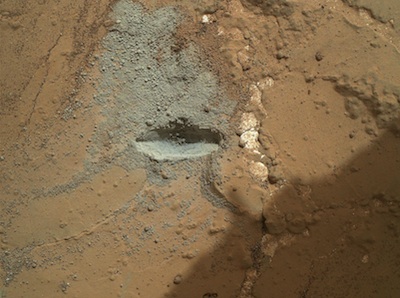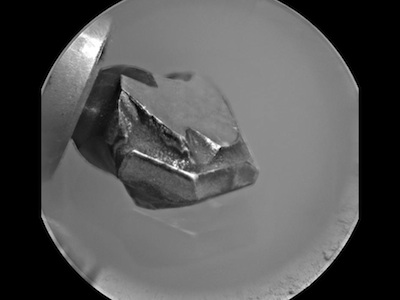
NASA exercises caution ahead of Curiosity's first drill
BY STEPHEN CLARK
SPACEFLIGHT NOW
Posted: 5 February 2013

Six months after dropping to the surface of Mars suspended under a rocket pack resembling a sci-fi creation, NASA's Curiosity rover is preparing to drill into a slab of rock holding clues of the planet's watery past.

The bit in the rotary-percussion drill of NASA's Mars rover Curiosity left its mark in a target patch of rock called "John Klein" during a test Feb. 2 in preparation for the first drilling of a rock by the rover. Credit: NASA/JPL-Caltech/MSSS
|
Adopting a deliberate, cautious strategy to ensure the rover's drill is ready, engineers have positioned Curiosity near a rock formation dubbed "John Klein" for a series of tests progressively exercising more of the drill's functions.
Named for Curiosity's late deputy project manager, the outcrop is a flat patch of rock marked with veins of light-colored calcium sulfate materials such as gypsum or bassinite.
"On Earth, forming veins like these requires water circulating in fractures," said Nicolas Mangold of the Laboratoire de Planetologie et Geodynamique de Nantes in France, who works on Curiosity's ChemCam science team.
Beginning in late January, controllers put Curiosity through series of tests to gauge how the rover will react during a drill. Engineers first commanded the rover's drill to press down on four locations on the "John Klein" outcrop to check whether the amount of force applied by the drill matched predictions.
The drill is designed to hammer into rocks and collect material for analysis by the rover's chemical and mineral sensors. It is attached to the end of Curiosity's robot arm and uses percussive and spin motion to bore into rock.
"Drilling into a rock to collect a sample will be this mission's most challenging activity since the landing. It has never been done on Mars," said Richard Cook, Curiosity's project manager at the Jet Propulsion Laboratory in Pasadena, Calif.
"The drill hardware interacts energetically with Martian material we don't control," Cook said in a statement issued in January. "We won't be surprised if some steps in the process don't go exactly as planned the first time through."
On Saturday, engineers activated the drill for a test run using the device's percussive motion. The drill bit carved a small sliver in the rock about two-thirds of an inch long.
The next step is a "mini-drill" test employing the drill's rotary motion long enough to accumulate a ring of rock powder around a hole. Officials will study the powder to see if it is suitable to be ingested by Curiosity's sample handling mechanisms, according to NASA.

The shape of the tip of the bit in the drill of NASA's Mars rover Curiosity is apparent in this view recorded by the remote micro-imager in the rover's Chemistry and Camera instrument Jan. 29. The bit is about 0.6 inch (1.6 centimeters) wide. Credit: NASA/JPL-Caltech/LANL/CNES/IRAP/LPGNantes/CNRS
|
"We are proceeding with caution in the approach to Curiosity's first drilling," said Daniel Limonadi, lead systems engineer for Curiosity's surface sampling and science system, in a status report posted on NASA's website. "This is challenging. It will be the first time any robot has drilled into a rock to collect a sample on Mars."
The powder samples will be examined by miniature laboratories inside the rover body to determine the material's mineral and chemical composition.
The drill is the last of Curiosity's instruments to be used since it arrived on Mars six months ago.
Curiosity has logged more than 2,300 feet on its odometer since it landed Aug. 6.
The six-wheeled robot is now exploring a region known as "Yellowknife Bay," a shallow pit about two feet deep lying one-third of a mile from the rover's landing site.
Scientists picked the Yellowknife Bay region as Curiosity's first destination because orbital observations showed the area was made of different terrain than the rover's touchdown point.
"The orbital signal drew us here, but what we found when we arrived has been a great surprise," said John Grotzinger, Curiosity's lead scientist, in a statement. "This area had a different type of wet environment than the streambed where we landed, maybe a few different types of wet environments."
Curiosity's ultimate objective is Mount Sharp, a three-mile-high peak in Gale Crater, the ancient impact site where Curiosity landed.
Observations from satellites orbiting Mars show Mount Sharp's foothills could contain clays, which harken to a time when the planet was warmer and wetter.
|



